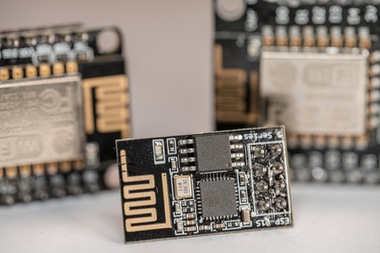☰ Menu
Menu

Though it may be difficult to predict the trends that will define PCB manufacturing in the future, one thing we can be sure of is that change is inevitable. Advancements in other industries and technologies demand that printed board assembly evolves to keep up. By examining the trends that define the current landscape of printed circuit board production, we can also look forward to what will affect PCB assembly services for the immediate future. Read on as we discuss 5 recent advances that are innovating circuit card assembly!
High Density Interconnect
Printed circuit boards are no different than most other technological advancements. Television sets, cell phones, and computers continue to shrink in size as their functionality grows exponentially. Similarly, high density interconnect was developed in response to the demand for smaller circuit cards. This capability allows for fewer layers in the PCB stack-up and also promotes signal transmission at higher speeds. This way, printed circuit boards can come in smaller packages while promising unprecedented function.
High Power Boards
PCB assembly services are trending towards higher power PCBs as a direct result of the growth in solar technology. Solar panels typically operate at 24V or 48V, and electric vehicles can operate at voltage levels in the hundreds. To meet the growing demand of high-powered technologies, printed circuit boards are now being made with supplies of up to 48V. This is being done by mounting larger components (such as battery packs) to circuit cards without compromising circuit interference.
Internet of Things (IoT)
As more and more aspects of everyday life synchronize with one another through the cloud, the IoT continues to expand its reach. Now, it is even impacting the way that PCBs are designed. This multi-tiered design strategy enables hyper-quick communication between layers and elements of a circuit card – usually done wirelessly, too. As we continue to integrate the IoT into circuit card assembly, the primary challenge going forward is meeting various standards and regulations that govern this innovative development.
Component Supply Chain Control
Increasing amounts of IoT and electronics integration doesn’t come without a cost. Advanced technologies (e.g., virtual reality and augmented reality simulations) are now being utilized during PCB assembly to address the issue of eliminating counterfeit components from the supply chain in order to protect critical systems manufacturing.
Commercial-Off-The-Shelf (COTS) Components
In the past, some components used by PCB assembly manufacturers have been heavily scrutinized and regulated. However, a trend defining modern PCB assembly is the commercialization of this industry. By using COTS components, there is a new sense of standardization, reliability, and accessibility to the components necessary for printed board assembly. We expect that this trend will lead to reduced regulation of components and make PCB assembly much more accessible.
At EEI, we expect that these industry trends will drive the continued evolution of PCB manufacturing technology for years to come. Meeting the innovative challenges of tomorrow requires leading PCB assembly companies who continue to adapt cutting-edge technologies and design processes. EEI is your leading choice to tackle these challenges – contact us today to learn more about our complete product design, technologies, and end-to-end integrated manufacturing services!